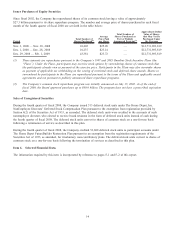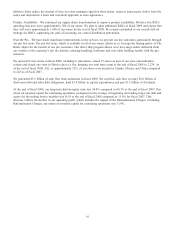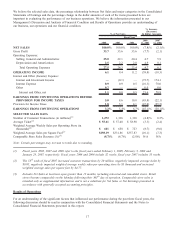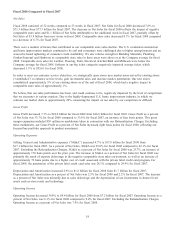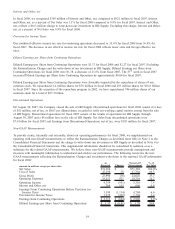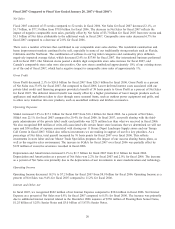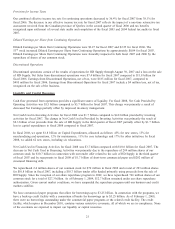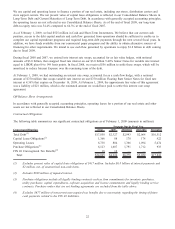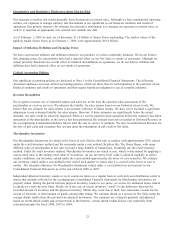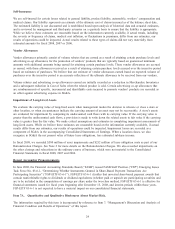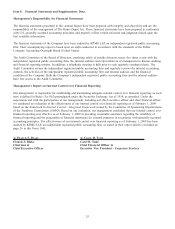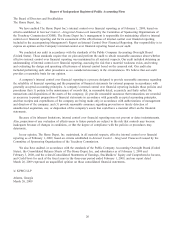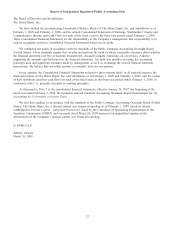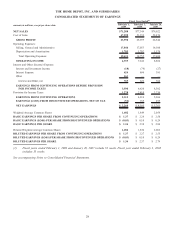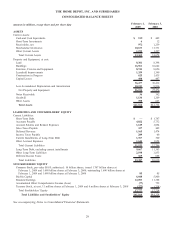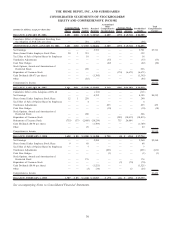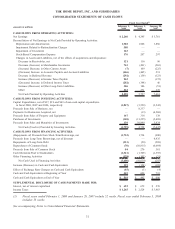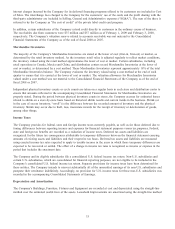Home Depot 2008 Annual Report Download - page 29
Download and view the complete annual report
Please find page 29 of the 2008 Home Depot annual report below. You can navigate through the pages in the report by either clicking on the pages listed below, or by using the keyword search tool below to find specific information within the annual report.
Self-Insurance
We are self-insured for certain losses related to general liability, product liability, automobile, workers’ compensation and
medical claims. Our liability represents an estimate of the ultimate cost of claims incurred as of the balance sheet date.
The estimated liability is not discounted and is established based upon analysis of historical data and actuarial estimates,
and is reviewed by management and third-party actuaries on a quarterly basis to ensure that the liability is appropriate.
While we believe these estimates are reasonable based on the information currently available, if actual trends, including
the severity or frequency of claims, medical cost inflation, or fluctuations in premiums, differ from our estimates, our
results of operations could be impacted. Actual results related to these types of claims did not vary materially from
estimated amounts for fiscal 2008, 2007 or 2006.
Vendor Allowances
Vendor allowances primarily consist of volume rebates that are earned as a result of attaining certain purchase levels and
advertising co-op allowances for the promotion of vendors’ products that are typically based on guaranteed minimum
amounts with additional amounts being earned for attaining certain purchase levels. These vendor allowances are accrued
as earned, with those allowances received as a result of attaining certain purchase levels accrued over the incentive period
based on estimates of purchases. We believe that our estimate of vendor allowances earned based on expected volume of
purchases over the incentive period is an accurate reflection of the ultimate allowance to be received from our vendors.
Volume rebates and advertising co-op allowances earned are initially recorded as a reduction in Merchandise Inventories
and a subsequent reduction in Cost of Sales when the related product is sold. Certain advertising co-op allowances that
are reimbursements of specific, incremental and identifiable costs incurred to promote vendors’ products are recorded as
an offset against advertising expense in SG&A.
Impairment of Long-Lived Assets
We evaluate the carrying value of long-lived assets when management makes the decision to relocate or close a store or
other location, or when circumstances indicate the carrying amount of an asset may not be recoverable. A store’s assets
are evaluated for impairment by comparing its undiscounted cash flows with its carrying value. If the carrying value is
greater than the undiscounted cash flows, a provision is made to write down the related assets to fair value if the carrying
value is greater than the fair value. We make critical assumptions and estimates in completing impairment assessments of
long-lived assets. While we believe these estimates are reasonable based on the information currently available, if actual
results differ from our estimates, our results of operations could be impacted. Impairment losses are recorded as a
component of SG&A in the accompanying Consolidated Statements of Earnings. When a location closes, we also
recognize in SG&A the net present value of future lease obligations, less estimated sublease income.
In fiscal 2008, we recorded $580 million of asset impairments and $252 million of lease obligation costs as part of our
Rationalization Charges. See Note 2 for more details on the Rationalization Charges. We also recorded impairments on
the other closings and relocations in the ordinary course of business, which were not material to the Consolidated
Financial Statements in fiscal 2008, 2007 and 2006.
Recent Accounting Pronouncements
In June 2008, the Financial Accounting Standards Board (“FASB”) issued FASB Staff Position (“FSP”) Emerging Issues
Task Force No. 03-6-1, “Determining Whether Instruments Granted in Share-Based Payment Transactions Are
Participating Securities” (“FSP-EITF 03-6-1”). FSP-EITF 03-6-1 clarifies that unvested share-based payment awards that
contain nonforfeitable rights to dividends or dividend equivalents (whether paid or unpaid) are participating securities and
are to be included in the computation of earnings per share under the two-class method. FSP-EITF 03-6-1 is effective for
financial statements issued for fiscal years beginning after December 15, 2008, and interim periods within those years.
FSP-EITF 03-6-1 is not expected to have a material impact on our consolidated financial statements.
Item 7A. Quantitative and Qualitative Disclosures About Market Risk.
The information required by this item is incorporated by reference to Item 7. “Management’s Discussion and Analysis of
Financial Condition and Results of Operations” of this report.
24


